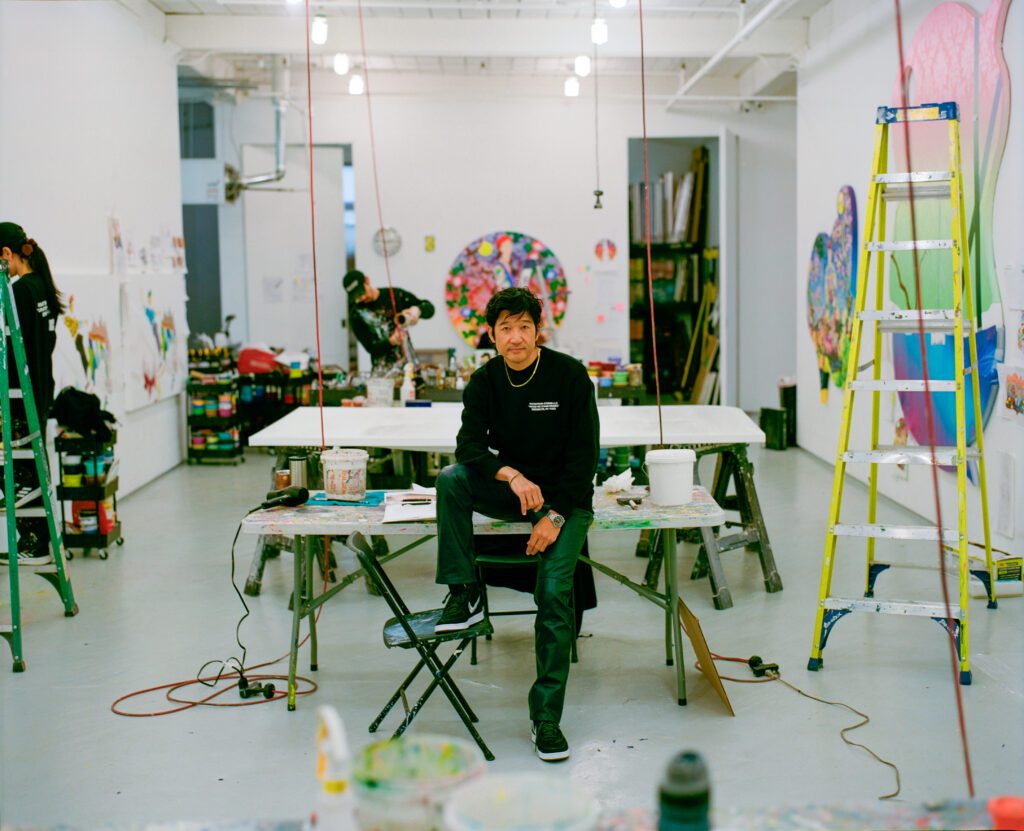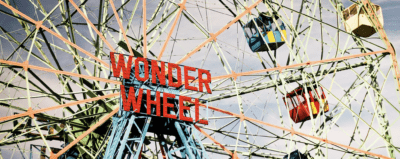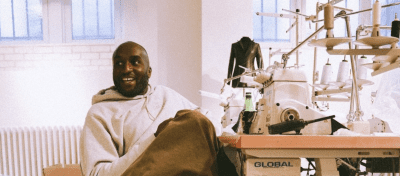'Mythologiques,' currently on view in Venice (photo by Francesco Russo)
Remix artist: Meet street artist-turned-gallery superstar Tomokazu Matsuyama
After 20 years of exploring cultural identity through art, the Japanese-born Brooklyn painter is conquering the world
Brooklyn-based artist Tomokazu Matsuyama is standing in the first of five airy chambers in his 8,000 square-foot studio high above Greenpoint, contemplating three monumental paintings that depict fashionable figures in lavish apartments. At first, the works’ clean yet whimsical lines evoke manga. In reality, though, these paintings collage fashionable imagery Matsuyama has copied from magazines, art history and more. The three works he’s standing before will head to Paris soon for a show Fondation Louis Vuitton is hosting around Pop Artist Tom Wesselman.
“My interest is to define cultural identity,” Matsuyama says, contemplating the paintings’ vibrant, varied iconography. It’s only getting more fluid, more complex.” His excitement regarding globalization feels like an antidote to the cynicism of our times. He likens his process to “hip hop DJs cutting, pasting and making hip hop, or house musicians making EDM on computers.”

Matsuyama in his studio (Photo by Elianel Clinton)
Buzzing around him are 28 assistants, coordinators and other staff members at work on canvases and computers alike, keeping Matsuyama’s many projects moving. In addition to fine art exhibitions, Matsuyama also creates public artworks and participates in brand collaborations. He currently has a show titled “Mythologiques” on view in Venice, adjacent to but not part of the the world’s premier art biennial, through November. He has sculptures and murals from Luxembourg to Los Angeles, has designed sets for J-Pop act Yuzu, and recently ended a year-long turf war on Manhattan’s storied Bowery Mural Wall. After decades at work, his market is taking off, too.
All this for an artist who taught himself how to paint, whose childhood (and childhood identity) were split between Southern California and his birthplace in Gifu, Japan. Matsuyama moved to New York in 2002 at 25 to study graphic design at Pratt Institute after an injury ended his semi-professional snowboarding career. He parlayed his bachelor’s in economics into art.
“You can be creative, but you have a steady job,” Matsuyama says of graphic design, which has taught him how to approach images like a science. “The way it’s creative thinking and problem solving really allowed me to be very creative, and has been a big impact.”
Matsuyama lived in Bushwick while at Pratt, but moved to Greenpoint, where he taught himself how to paint, after getting robbed one too many times. Steeped in the remix culture of the 1990s, he started sampling imagery from magazines, museums, and the streets into maximalist compositions that mimic the way we use pop culture and social media to build identities today.
Early on, he showed his work in local cafes, and started painting murals in a style evoking Takashi Murakami’s “superflat” movement in its meticulousness, which has since become ubiquitous in public art. Then, in the 2010s, street art exploded. Matsuyama’s bold but delicate style stood apart from the work of his famous friends like KAWS, in part, due to his upbringing.


‘Serenity Exhale Protection’ (Courtesy of Tomokazu Matsuyama)
While Matsuyama has said that he felt like an American kid growing up, the artist retained his Japanese sensibilities as a young New Yorker, in an era before iPhones. “Going to the newsstand was just as exciting as going to the MoMA or the Met, because you got to understand cutting edge, up-to-date culture,” he says, positioned in front of “Serenity Exhale Protection,” one of the three works bound for Paris, holding a folder stuffed with printouts of the painting’s references.
Matsuyama was shocked to see celebrity’ homes in Elle Decor. “I come from Japan, where the country is still very reserved,” he says. Welcoming photographers behind closed doors seemed awfully intimate. “The celebrities are getting bare naked,” he thought. “I was very taken away.”
Matsuyama pulls a copy of an Architectural Digest spread from his folder. Its regal red couch, chair, and table match the furnishings in “Serenity Exhale Protection.” He’s cooled down the digs by painting the walls, instead, with a baby blue floral pattern by textile designer William Morris. Elsewhere, he’s turned the temperature up a notch, by substituting the staid painting behind the couch in the original photograph with late Renaissance painter Artemisia Gentilleschi’s “Judith Beheading Holofernes’,” a violent feminist artwork about class struggle that resonates with his experiences as a minority. Figs and other fruits lying about reference 17th century Dutch painters — and, tucked below, there’s a playful feline in the Japanese “drunken cat” style.
Doing away with hierarchies of high and low culture, Matsuyama comingles a crumpled Starburst rapper and an empty can of Colt 45 with triumphs of art and design in “Silence Wind Flower Believe,” another work in the Paris trio. Most of his figures are taken from fashion spreads. He dresses them in timeless garments enlivened by ornate, often historic, patterns.


‘Safety Retrospective’ (courtesy of Tomokazu Matsuyama)
In “Safety Retrospective,” the third work in the series, a girl crouches defiantly on a couch in a baroque living room, hanging out with two other friends. The edgy scene features a turntable, an ashtray with a smoldering cigarette in it, and a blaze in the fireplace — which actually resembles the Romantic painter J.M.W. Turner’s painting “The Burning of the Houses of Lords and Commons, 16th October, 1834.” And, in a nod to the Paris retrospective where this particular artwork is heading, Matsuyama has replaced the Wesselman painting pictured in the original interior with a flag by the political, provocative artist David Hammons.
Matsuyama’s studio can only produce 30 paintings like these a year, so he’s intentional with his time. Gallery and museum shows are nice, but they can be elitist. While cutting his teeth as a public artist, Matsuyama learned to value direct dialogue with real people — community members and smaller collectors.
“You become part of art history, every artist wants that,” Matsuyama said of museum shows. “But we also have to make sure that you have a dialogue with the community that you live with.”
Still, Matsuyama’s most impressive public artwork of late is one of the few he’s done illegally. Goldman Global Arts first had him paint the Bowery Mural Wall in 2019. Goldman typically asks a few lucky artists to paint their wall each year. It’s the ultimate feather in a street artist’s cap.
In 2022, Goldman invited LA-based artist David Flores to paint the wall. Some of NYC’s more combative graffiti writers made it clear they didn’t like the out-of-towner’s style by repeatedly bombing his mural. The situation got so out of hand that Goldman relinquished control of the wall for about a year — until Matsuyama got involved last fall. He designed 33 tiled portraits depicting notable New Yorkers into a work titled “From the streets of New York to shows in Paris and Venice: The art of Tomokazu Matsuyama,” then had it printed on vinyl for an easy installation, which his team carried out in under two days — unsanctioned. At first, Goldman Global Arts was apprehensive, but when they saw that civilians and graffiti writers alike enjoyed Matsuyama’s addition, they made his artwork official. The piece is still riding today.
Meanwhile, of Matsuyama’s 24 global solo shows so far, “Mythologiques” — organized by Turkey’s Contemporary Istanbul Foundation following his participation in 2022’s Istanbul Biennale — might be his most mesmerizing yet. Five larger-than-life paintings encircle viewers, including an intricate interior, a jungle exterior, a car traversing a psychedelic landscape, and a salon painting with dense rows of replica artworks in it. A checkered starburst radiates from the floor, enhancing the hypnotic effect: As humanity grows more interconnected and complicated, people must learn to see each other as humans above all else.
And where else could such a movement, and such a show — staged in Italy and hosted by Turkey, with a Swiss curator and a Japanese-American artist — take shape, but in Brooklyn?
You might also like 


























